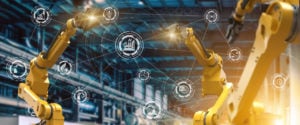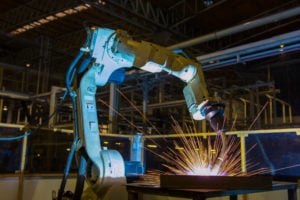Before Smart Manufacturing
Advancements in manufacturing have been ongoing for centuries and Smart Manufacturing is just another step forward, but to truly appreciate where the future lies for industry, we must look at how the journey began in order to see how smart manufacturing can grow your business. In the early 1700s, steam power constituted an important power source for industrial society during its time, followed by the assembly line, then automation, and data-enhanced automation. Now, during the age of Smart Manufacturing, we are using the data to analyze trends to determine steps in their processes where production slows down or is inefficient. We are now in a new industrial revolution known to some as Industry 4.0 or Smart Manufacturing.
With upside like long-term savings, improved efficiency, and increased productivity, the benefits to factories are reason enough to consider the possibility of Industry 4.0. So, what exactly is Smart Manufacturing and how can it make your organization more productive and more profitable? Let’s start with what it actually means.
What is Smart Manufacturing and How Can it Grow Your Business?

Smart Manufacturing is the intelligent, technology-driven approach that applies network-connected machinery to monitor the production process. The main goal is to identify potential opportunities for improving and automating manufacturing performance.
Smart Manufacturing is just one of many applications of the Industrial Internet of Things. From embedding sensors in manufacturing machines to collecting data on their operational status and performance, it has the ability to be utilized in many ways, and even many not yet realized. In the past, collected data was generally held in local databases on single devices; data was siloed. This type of information could then be used for determining causes of system failures and more, however, it was time-consuming and caused delays and additional unnecessary expenses.
Use Cases for Smart Manufacturing
The opportunities with data that is generated from network sensors bring visibility into previously boring systems and processes. A McKinsey & Company report studied the impact of automation in manufacturing driven by rapid advances in robotics, AI, and machine learning and said that 87% of hours workers spend in production could be automated with existing technologies. Here are just a few areas of Smart Manufacturing that could work in manufacturing:
- Remote Mentoring
- Condition Monitoring
- Predictive Maintenance
Now, let’s explore some real-world examples.
Remote Mentoring and Productivity

Remote Mentoring connects field reps/technicians with a remote resource (aka subject matter expert) to aid in the completion of a task. More so, it enables individuals to connect with each other and see the same information from afar. In this case, it allows the completion of a hands-free task using verbal communication allowing workers to enter data from the site location without the time-consuming task of manual entry. Remote Mentoring also allows organizations to track whether a job was done properly, stay on top of compliance and reports for regulatory agencies, and more. With Connected Worker and Remote Mentoring, there is an opportunity to document workflow for the repair or maintenance task and then use it later as a training tool for employees to learn from.
Condition Monitoring
Condition Monitoring is a maintenance activity that monitors the condition of your equipment to detect defects and determine the necessary maintenance to perform. Unlike planned maintenance, where maintenance is performed based upon predefined scheduled intervals, the goal of condition monitoring or condition-based maintenance is to identify the need for corrective maintenance when it is needed. Sensors are applied to track changes in oil quality and cleanliness, temperatures, vibration, and more. Then the system reports any issues with corrosion, wear, misalignment, imbalance, lubrication, etc.
Most monitoring techniques require a tech to check equipment under normal operating conditions. As such, safety becomes an issue. With sensors, real-time data can be analyzed without ever exposing employees to safety risks in the workplace. By utilizing condition monitoring, work is only ever completed when it needs to be. This can eliminate a substantial amount of preventative maintenance work that is now otherwise unnecessary, freeing up an organization’s resources for more valuable tasks.
Predictive Maintenance
Consider the auto manufacturer who is using Artificial Intelligence (AI) or robots to build cars and increase the speed of production. AI and Robotics have enabled great benefits for the manufacturer already, however, what happens when the robot breaks down? What solutions are there to keep the robot operating or to prevent it from breaking down before it happens? Obviously, if the system breaks then production grinds to a halt.

With Smart Manufacturing, it is possible to expose the potential/likelihood of a breakdown before it happens through manufacturing engineers and data analysts that remotely analyze data across multiple factories. This enables corrective maintenance planning to service equipment most likely to fail before it reaches the point of failure, greatly reducing the risk of lost revenue. Through similar computer-assisted methods, it’s even possible to extend predictive maintenance – highlighting problems before they occur and take steps to mitigate the financial costs.
IIoT creates the ability for smart manufacturing to use more machines all networked together. Those machines will be better able to communicate with each other, potentially supporting greater levels of automation. For example, they might be able to automatically place an order for supplies that could run low or even designate equipment to specific jobs. This data can be used for simulations of different processes as well.
The Benefits of a Smart Factory
Smart Manufacturing technologies offer solutions that when brought together bring higher profitability and better outcomes.
In a smart factory, productivity is constantly enhanced. If a machine begins to slow production, then the data will note it, and the systems will work to resolve and correct the issue. These types of systems are extremely adaptable and enable greater flexibility.
In terms of efficiency, a main area of savings comes from the reduction in production downtime. Smart Manufacturing machines come with remote sensors and diagnostics to alert operators to problems as they happen. A well-designed smart factory includes automation as well as human-machine collaboration, features that enable operational efficiency.
The savings over the long term will outweigh the startup costs and organizations have to plan for the future even if they can’t implement smart factories immediately. Traditional manufacturing focuses on the economy of scale and machine utilization. If a machine was idle, it lost money, so companies just kept them running continuously. The difference is that in smart manufacturing it is a collaborative, fully-integrated manufacturing system that responds in real-time to meet changing conditions and demands around supply, customers, and the needs of the factory.
What’s Next
You may be at the start of your journey into digital transformation or would like to add a use case to an existing system. Where you may be in your journey, you will likely need a systems integrator. A systems integrator specializes in bringing together component subsystems into a whole and ensuring that those subsystems function together, a practice known as system integration. CBT puts solutions together for businesses interested in finding a solution to automating any part of their current process.
CBT’s goal is to optimize the manufacturing process using a technology-driven approach that utilizes network-connected machinery to monitor the production process. Our process allows organizations to locate opportunities for automating operations and use data analytics to improve manufacturing performance.
It is time to discover how digital transformation can move your business to the next level. Schedule a meeting with us and see how we can work with you on initial stages utilizing social distancing. It’s as simple as doing a real-time, virtual demo using our Connected Worker technologies to uncover the most pressing use cases for your business.
Schedule a Meeting to learn more.
